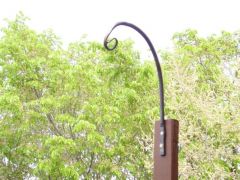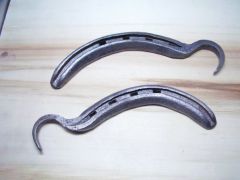
easilyconfused
Members-
Posts
716 -
Joined
-
Last visited
Content Type
Profiles
Forums
Articles
Gallery
Downloads
Events
Everything posted by easilyconfused
-
Would this be what's known as a red short type of steel?
-
We got taught to punch a small hole before splitting. You could drill it too. It depends on whether you want a round or split look. Some people like either look.
-
Just Curious...How many have gotten a Tetanus Shot?
easilyconfused replied to cbl4823's topic in Safety discussions
You want to make sure you're up to date on your tetnus. If you do anything that can cause a puncture or deep cut. The bacteria in question are what are known as anaerobes, as in they need to have no oxygen to grow and produce toxins, hence the punctures and deeps cuts. The bacteria produce a toxin, like it has been said. The bacteria itself is usually the easy part of getting rid of the problem. However, the signs are caused by the toxin itself, not the bacteria so once the signs show up, you have very few options for treatment and you are still laid up with the muscle spasms and such in the meantime. By getting your immune system primed by the vaccine, it is ready to bind up any of the toxin that is produced before it is able to affect the nerves and cause the signs. I don't know the numbers for people but in cattle, the prognosis for survival is >20% with treatment, if you get the disease. It is probably much better in people but still, I don't want to be conscience while my muscles spasm as tight as they can get. -
The nice thing about charcoal is that it floats so you just have to scoop it out of the water with a metal strainer.
-
I also let the fire slowly get smaller at the end. By that time, I've usually got little things to do like heating for wax or I'll work on smaller hooks from nails or something, rather than keeping my fire big. Scooping the fire into the water would be another option if you were able to keep sparks from getting out.
-
Bird Feeder Hangers...
easilyconfused replied to andgott's topic in Blacksmithing, General Discussion
Here's a pic of the hanger. I did a pigtail to hold the feeder on better in the wind. -
5198_514429952313_122200757_30675341_189706_n
easilyconfused posted a gallery image in Member Galleries
-
2628_509833129383_122200757_30623021_334192_n
easilyconfused posted a gallery image in Member Galleries
-
I've got a callus where that blister used to be on my hand. It's from the end of the handle rubbing back and forth. As for the proper technique, I don't know if I'm following the Hofi style much but from the pictures of me, I seem to use a similar technique. Personally, I'd rather have the blister there from letting the hammer pivot than my wrist damaged from doing the moving for the hammer. A smooth handle will help with it. I also get a bit of a blister between my thumb and index finger from the hammer pivoting there too. I used to frame houses with my dad and the old guy he worked with taught me to "milk" the handle like you would a cow. That way the snap comes from your fingers pulling on the handle rather than your wrist which is really important with a lighter hammer as it's the snap that works moreso than the weight. Your sore forearm may be due to muscle fatigue as I get sometimes after a long break from the forge, or tendons. Either way, take it easy and take breaks when you start to get tired or you will wind up with tendonitis in your elbow. And remember to stretch and if you need to, alternate heat and cold on it.
-
Rivets: upsetting small rod
easilyconfused replied to john_zxz's topic in Blacksmithing, General Discussion
Too add to the previous post, don't draw it down exactly like a nail. Too much taper and it will fold over. Draw it down a bit and round up to the size of hole. There's a formula I can't remember off the top of my head for the length to diameter ratio so you don't have too much metal. Hammer control is important too. -
A balanced stance is important too, one foot in front of the other a bit. That way I can use my whole body, not just my arm. Keeps from tiring me out and lets my lock my forearm a bit better to keep things true.
-
You need to work it at a bright orange to yellow, depending on your shop lighting. It could also be the metal. I've had nothing but troubles putting leafs on hooks with one batch of round rod and no problems doing the same with other. Although the scale would say other wise, make sure the iron has heated long enough for the center to be hot too. Too much scale may also mean an oxidizing fire and there is too much oxygen. When you burn the metal, there are usually sparks. Butter yellow is getting close to welding temperature. To prevent cracks, you may need to work close to that temperature with the steel batch you have.
-
Only old posts that aren't treated around here are usually trembling aspen, aka Poplar. Old wagon wheels and such usually give some nice wood though.
-
Aussie Brush Fires Leaf Memorial, make and send leaves.
easilyconfused replied to salty's topic in Metal Sculpture & Carvings
Should have "" my insurance. I meant for surety, not true pay-me-if-it-goes-wrong insurance but insurance on our part that it won't go wrong. At least not as quickly anyways :rolleyes: -
Could also be used to twist pieces of the right size square?
-
Guess I ought to go ahead and quit my day job
easilyconfused replied to Mothrog's topic in Knife Making
or at least the idea to pretend he's had offers. Notice how it was his post, not an answer to a question. -
Aussie Brush Fires Leaf Memorial, make and send leaves.
easilyconfused replied to salty's topic in Metal Sculpture & Carvings
It's officially in the mail express post to Jim in california. Hope it makes it. Didn't get a deep etch but oh well, wouldn't be able to go looking for it anyways. Will need better passivation though. I'm assuming you guys will be making sure they all get done on your end for insurance anyways? Ryan Ridgway Avonlea/Saskatoon Saskatchewan Canada -
Aussie Brush Fires Leaf Memorial, make and send leaves.
easilyconfused replied to salty's topic in Metal Sculpture & Carvings
Here's a picture of my little gaffer. Just need to etch my touchmark on it. Hopefully the car battery charger method works better than trying to scratch it in with a file. And then hopefully I can get it down to the shipping point by the deadline! -
What steel is a band-saw blade made of?
easilyconfused replied to westerwald's topic in Blacksmithing, General Discussion
Short answer, depends on the bandsaw blade. -
Generally speaking, a farrier's anvil has little mass under the body and most of it in the horn. That's why you can't work too heavy on them, the waist is too small to withstand. Also, the heel is usally too thin to do much on too.

